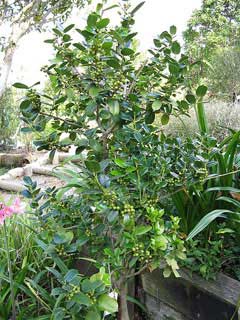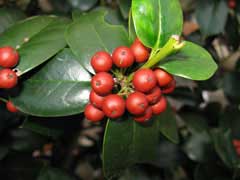 |
|
http://commons.wikimedia.org/wiki/User:KENPEI |
 |
| http://commons.wikimedia.org/wiki/User:KENPEI |
Translate this page:
Summary
Bloom Color: White. Main Bloom Time: Early spring, Late spring, Mid spring. Form: Rounded, Vase.
Physical Characteristics

 Ilex cornuta is an evergreen Shrub growing to 4 m (13ft) by 5 m (16ft) at a medium rate.
Ilex cornuta is an evergreen Shrub growing to 4 m (13ft) by 5 m (16ft) at a medium rate.
See above for USDA hardiness. It is hardy to UK zone 6. It is in leaf all year, in flower in April, and the seeds ripen from October to December. The species is dioecious (individual flowers are either male or female, but only one sex is to be found on any one plant so both male and female plants must be grown if seed is required). and is pollinated by Bees. The plant is not self-fertile.
Suitable for: light (sandy), medium (loamy) and heavy (clay) soils. Suitable pH: mildly acid, neutral and basic (mildly alkaline) soils. It can grow in semi-shade (light woodland) or no shade. It prefers moist soil.
UK Hardiness Map
US Hardiness Map
Synonyms
Plant Habitats
Woodland Garden Dappled Shade; Shady Edge;
Edible Uses
Edible Parts: Fruit
Edible Uses:
The fruit is thin-skinned with a sweet taste[178]. Is this report suggesting that it is edible?[K].The fruit is about 8 - 10mm in diameter[200].
References More on Edible Uses
Medicinal Uses
Plants For A Future can not take any responsibility for any adverse effects from the use of plants. Always seek advice from a professional before using a plant medicinally.
Abortifacient Carminative Contraceptive Febrifuge Tonic
The whole plant is abortifacient, carminative, contraceptive, febrifuge and tonic[147, 178]. It particularly strengthens the back and knees[147]. The leaf is made into a tea which is said to be contraceptive if used by women and is also used for termination pregnancies[218]. The stem bark is tonic[218]. The whole plant is used in the treatment of arthritis, recurring fever in pulmonary tuberculosis, tubercular lymph nodes, joint pained and lumbago[147, 218].
References More on Medicinal Uses
The Bookshop: Edible Plant Books
Our Latest books on Perennial Plants For Food Forests and Permaculture Gardens in paperback or digital formats.

Edible Tropical Plants
Food Forest Plants for Hotter Conditions: 250+ Plants For Tropical Food Forests & Permaculture Gardens.
More

Edible Temperate Plants
Plants for Your Food Forest: 500 Plants for Temperate Food Forests & Permaculture Gardens.
More

More Books
PFAF have eight books available in paperback and digital formats. Browse the shop for more information.
Shop Now
Other Uses
References More on Other Uses
Cultivation details
Landscape Uses:Border, Espalier, Pest tolerant, Screen, Standard, Specimen, Street tree. Succeeds in most soils that are not water-logged[200]. Plants are hardy to about -15°c[184]. Resents root disturbance, especially as the plants get older[11]. It is best to place the plants into their permanent positions as soon as possible, perhaps giving some winter protection for their first year or two[K]. Plants are very tolerant of pruning and can be cut right back into old wood if required[188]. A number of named forms have been developed for their ornamental value[182]. Dioecious. Male and female plants must be grown if seed is required. Special Features:Not North American native, Inconspicuous flowers or blooms.
References Carbon Farming Information and Carbon Sequestration Information
Temperature Converter
Type a value in the Celsius field to convert the value to Fahrenheit:
Fahrenheit:
The PFAF Bookshop
Plants For A Future have a number of books available in paperback and digital form. Book titles include Edible Plants, Edible Perennials, Edible Trees,Edible Shrubs, Woodland Gardening, and Temperate Food Forest Plants. Our new book is Food Forest Plants For Hotter Conditions (Tropical and Sub-Tropical).
Shop Now
Plant Propagation
Seed - best sown as soon as it is ripe in the autumn in a cold frame. It can take 18 months to germinate. Stored seed generally requires two winters and a summer before it will germinate and should be sown as soon as possible in a cold frame. Scarification, followed by a warm stratification and then a cold stratification may speed up the germination time[78, 80]. The seedlings are rather slow-growing. Pot them up into individual pots when they are large enough to handle and grow them on in light shade in a cold frame for their first year. It is possible to plant them out into a nursery bed in late spring of the following year, but they should not be left here for more than two years since they do not like being transplanted. Alternatively, grow them on in their pots for a second season and then plant them out into their permanent positions in late spring or early summer. Give them a good mulch and some protection for their first winter outdoors. Cuttings of almost ripe wood with a heel, August in a shaded position in a cold frame. Leave for 12 months before potting up. Layering in October. Takes 2 years.
Other Names
If available other names are mentioned here
Native Range
TEMPERATE ASIA: China (Hubei Sheng (east), Shandong Sheng), Korea
Weed Potential
Right plant wrong place. We are currently updating this section.
Please note that a plant may be invasive in one area but may not in your area so it's worth checking.
Conservation Status
IUCN Red List of Threatened Plants Status :

| Related Plants
|
| Latin Name | Common Name | Habit | Height | Hardiness | Growth | Soil | Shade | Moisture | Edible | Medicinal | Other |
| Ilex aculeolata | | Shrub | 3.0 |
-
| | LMH | SN | M | 1 | 0 | |
| Ilex aquifolium | Holly, English holl, Christmas Holly, Common Holly, English Holly | Shrub | 9.0 |
5-9
| S | LMH | FSN | DM | 2 | 2 | 4 |
| Ilex asprella | | Shrub | 3.0 |
-
| | LMH | SN | M | 0 | 2 | |
| Ilex cassine | Cassine, Dahoon, Cassine Holly | Tree | 10.0 |
7-11
| S | LMH | SN | M | 1 | 1 | 2 |
| Ilex chapaensis | | Shrub | 10.0 |
-
| | LMH | SN | M | 1 | 0 | |
| Ilex coriacea | Large Gallberry | Shrub | 3.0 |
6-9
| | LMH | SN | M | 1 | 0 | |
| Ilex crenata | Japanese Holly, Box Leaved Holly | Shrub | 5.0 |
6-8
| S | LMH | SN | M | 1 | 0 | 3 |
| Ilex glabra | Inkberry | Shrub | 3.0 |
3-7
| S | LMH | SN | M | 1 | 0 | 2 |
| Ilex integra | Mochi Tree | Tree | 6.0 |
6-9
| | LMH | SN | M | 1 | 0 | |
| Ilex latifolia | Tarajo | Tree | 10.0 |
6-9
| | LMH | SN | M | 1 | 0 | |
| Ilex macropoda | | Tree | 13.0 |
6-9
| | LMH | SN | M | 1 | 0 | |
| Ilex opaca | American Holly | Shrub | 15.0 |
4-8
| S | LMH | SN | M | 2 | 2 | 3 |
| Ilex pedunculosa | | Shrub | 10.0 |
4-8
| | LMH | SN | M | 1 | 1 | 3 |
| Ilex pubescens | | Shrub | 3.5 |
7-10
| | LMH | SN | M | 0 | 2 | |
| Ilex purpurea | | Tree | 12.0 |
7-10
| | LMH | SN | M | 0 | 2 | |
| Ilex rotunda | Kurogane holly | Tree | 20.0 |
6-9
| | LMH | SN | M | 0 | 1 | |
| Ilex verticillata | Winterberry, Common winterberry | Shrub | 2.0 |
3-7
| S | LMH | SN | MWe | 1 | 3 | |
| Ilex vomitoria | Yaupon Holly, | Shrub | 6.0 |
6-9
| S | LMH | SN | M | 1 | 1 | 3 |
| Ilex x altaclerensis | Holly | Shrub | 4.0 |
5-9
| S | LMH | SN | M | 0 | 0 | 3 |
| Ilex yunnanensis | | Shrub | 4.0 |
5-9
| | LMH | SN | M | 0 | 1 | |
| Quercus ilex | Holly Oak, Evergreen Oak | Tree | 25.0 |
7-10
| S | LMH | SN | M | 5 | 2 | 3 |
| Quercus ilex ballota | Holm Oak | Tree | 25.0 |
6-9
| S | LMH | SN | M | 5 | 2 | 3 |
|
Growth: S = slow M = medium F = fast. Soil: L = light (sandy) M = medium H = heavy (clay). pH: A = acid N = neutral B = basic (alkaline). Shade: F = full shade S = semi-shade N = no shade. Moisture: D = dry M = Moist We = wet Wa = water.
Now available:
Food Forest Plants for Mediterranean Conditions
350+ Perennial Plants For Mediterranean and Drier Food Forests and Permaculture Gardens.
[Paperback and eBook]
This is the third in Plants For A Future's series of plant guides for food forests tailored to
specific climate zones. Following volumes on temperate and tropical ecosystems, this book focuses
on species suited to Mediterranean conditions—regions with hot, dry summers and cool, wet winters,
often facing the added challenge of climate change.
Read More
Expert comment
Author
Lindl.&Paxton.
Botanical References
11200266
Links / References
For a list of references used on this page please go here
Readers comment
| Add a comment |
|
If you have important information about this plant that may help other users please add a comment or link below. Only comments or links that are felt to be directly relevant to a plant will be included. If you think a comment/link or information contained on this page is inaccurate or misleading we would welcome your feedback at [email protected]. If you have questions about a plant please use the Forum on this website as we do not have the resources to answer questions ourselves.
* Please note: the comments by website users are not necessarily those held by PFAF and may give misleading or inaccurate information.
To leave a comment please Register or login here All comments need to be approved so will not appear immediately.
|
|